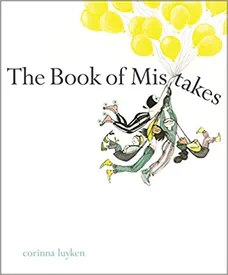The Book of Mistakes

Recommended Age Range: Kindergarten through 3rd grade.
Publisher's Summary:
As one artist incorporates accidental splotches, spots, and misshapen things into her art, she transforms her piece in quirky and unexpected ways, taking readers on a journey through her process. Told in minimal, playful text, this story shows readers that even the biggest “mistakes” can be the source of the brightest ideas—and that, at the end of the day, we are all works in progress, too.

Dr. Annie's Takeaways
Recommended for: Children who struggle to tolerate making mistakes may be inspired by this book to see mistakes as opportunities. It’s a beautiful book about art, and creativity, and being a work-in-progress. Therapists and/or caregivers may enjoy using this book to segue into an art activity that plays with mistakes.
Would a child like it? A child would likely enjoy watching the narrator’s process of creating a fun, whimsical work of art. Some children may be a bit confused by the ending, but I don’t think that will negate their enjoyment of the story.
Evidence-Based Practices:
Cognitive Restructuring
Tone: Playful, intimate
Story Quality: At surface level, this is a fun story about how mistakes can inspire creativity. It really succeeds on this level. The story is written in first person; the author is commenting on her drawing process, including what she views as mistakes and how these mistakes open up the possibility of aspects she is happy with (e.g., “Making the other eye even bigger was another mistake. But the glasses–they were a good idea”). It also has depth–it ends with the subtle message that we, as humans, are also constantly developing through our mistakes and creativity. Adults may appreciate this message more than children will, but it’s really beautifully done. This is one of those children’s books that adults will purchase to give to other adults as a graduation present, etc. It’s poetic.
Illustrations: The illustrations drive the soul of the book. They’re fun and quirky and beautiful. At times, they have a childlike feel to them, and in aggregate, they’re gorgeous and sophisticated.
Representation: The story is written in first-person, and the narrator doesn’t share any identifying characteristics. The author is drawing a White girl (in black-and-white), and in the end, it broadens into the author commenting on the many possibilities of a girl’s future: “Do you see–how with each mistake she is becoming? Do you see–now who she could be?”
Psychological Practices: The author holds mistakes and successes next to each other with very little judgment about either. The mistakes create space and opportunity for the successes and add character to her work. For a child who tends to see mistakes as canceling out or ruining successes, this book presents a cognitive shift–that mistakes can open up opportunities and co-exist with successes. This would be really fun to follow up with a mistakes-based art activity (one idea: start to draw something with one’s eyes closed, and then open them up and complete the piece with whatever “mistakes” are there). It has a similar message to Beautiful Oops
but with a bit more style.
Concerns: None
